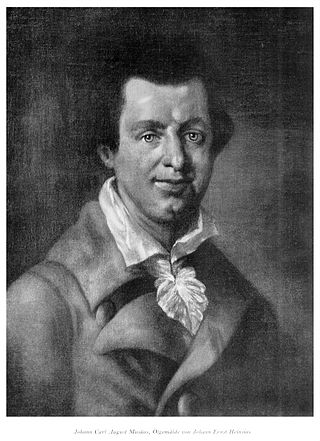
Thuringia, officially the Free State of Thuringia, is a state of central Germany, covering 16,171 square kilometres (6,244 sq mi), the sixth smallest of the sixteen German states. It has a population of about 2.1 million.

The University of Königsberg was the university of Königsberg in East Prussia. It was founded in 1544 as the world's second Protestant academy by Duke Albert of Prussia, and was commonly known as the Albertina.

Anna Amalia of Brunswick-Wolfenbüttel, was a German princess and composer. She became the duchess of Saxe-Weimar-Eisenach by marriage, and was also regent of the states of Saxe-Weimar and Saxe-Eisenach from 1758 to 1775. She transformed her court and its surrounding into the most influential cultural center of Germany.
Karl-August may refer to:

Johann Karl August Musäus was a German author and philologist. He was one of the first collectors of German folk stories, most celebrated for his Volksmärchen der Deutschen (1782–1787), a collection of German fairy tales retold as satires.

The Fruitbearing Society was a German literary society founded in 1617 in Weimar by German scholars and nobility. Its aim was to standardize vernacular German and promote it as both a scholarly and literary language, after the pattern of the Accademia della Crusca in Florence and similar groups already thriving in Italy, followed in later years also in France (1635) and Britain.

Saxe-Weimar was one of the Saxon duchies held by the Ernestine branch of the Wettin dynasty in present-day Thuringia. The chief town and capital was Weimar. The Weimar branch was the most genealogically senior extant branch of the House of Wettin.

Charles Frederick was the reigning Grand Duke of Saxe-Weimar-Eisenach.

Johann Gustav Stickel was a German theologian, orientalist and numismatist at Jena University.

Charles Alexander was the ruler of Saxe-Weimar-Eisenach as its grand duke from 1853 until his death.

St. Thomas School, Leipzig is a co-educational and public boarding school in Leipzig, Saxony, Germany. It was founded by the Augustinians in 1212 and is one of the oldest schools in the world.

Ferdinand Jagemann was a German painter; known primarily for his portraits.

Johann Traugott Leberecht Danz was a German Lutheran theologian and church historian born in Weimar.

Friedrich Wilhelm Riemer was a German scholar and literary historian. He worked in the households of Wilhelm von Humboldt and Johann Wolfgang von Goethe.

Schloss Weimar is a Schloss (palace) in Weimar, Thuringia, Germany. It is now called Stadtschloss to distinguish it from other palaces in and around Weimar. It was the residence of the dukes of Saxe-Weimar and Eisenach, and has also been called Residenzschloss. Names in English include Palace at Weimar, Grand Ducal Palace, City Palace and City Castle. The building is located at the north end of the town's park along the Ilm river, Park an der Ilm. It forms part of the World Heritage Site "Classical Weimar", along with other sites associated with Weimar's importance as a cultural hub during the late 18th and 19th centuries.

The Collegium Fridericianum was a prestigious gymnasium in Königsberg, Prussia. Alumni were known as Friderizianer.
Events from the year 1819 in Germany.
Christian Johann Christoph Schreiber was a German theologian, philologist, philosopher, and poet. He was also the Superintendent of the dioceses of Lengsfeld and Dermbach. He was connected in friendship or correspondence to writers and philosophers of his time, and published poetry, sermons, historical and philosophical works.

Johann Karl Ludwig Schorn, after 1838 von Schorn was a German art historian and university Professor. His second wife was the poet, Henriette von Schorn.

















